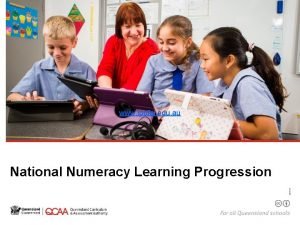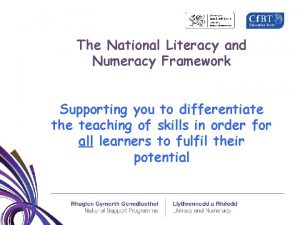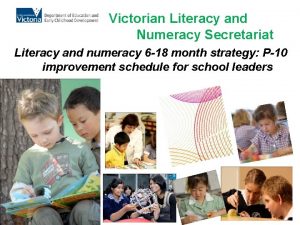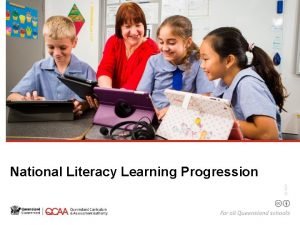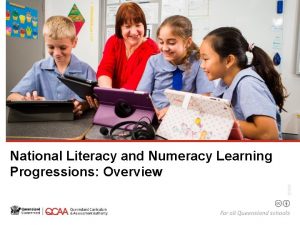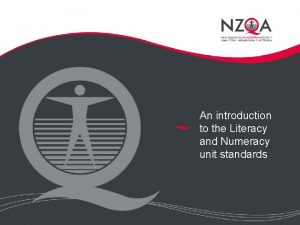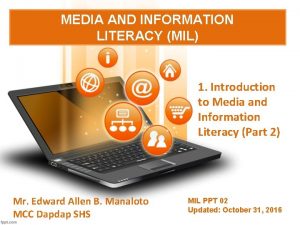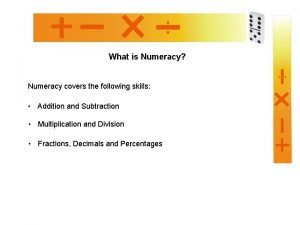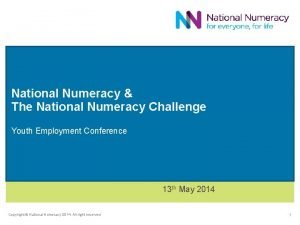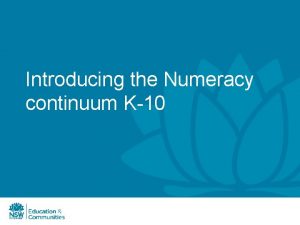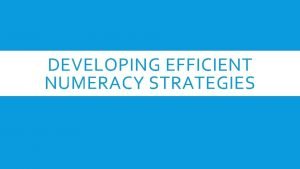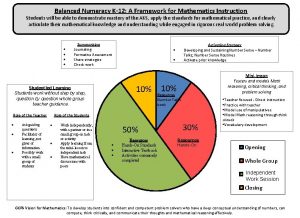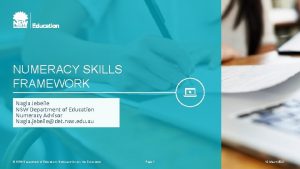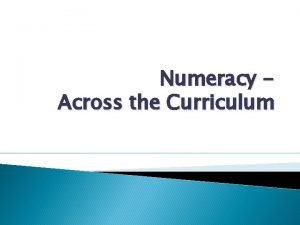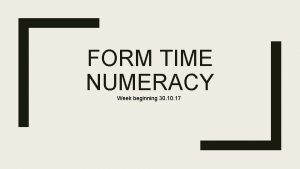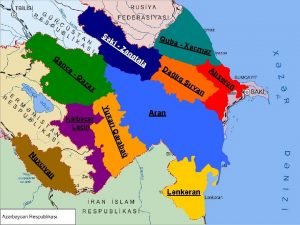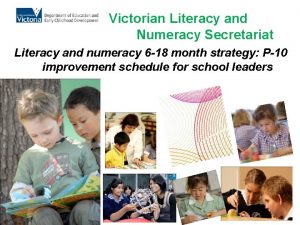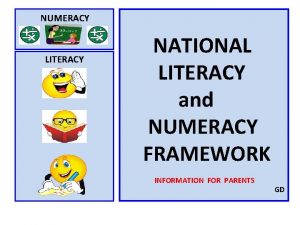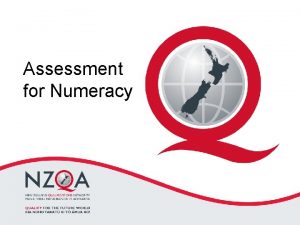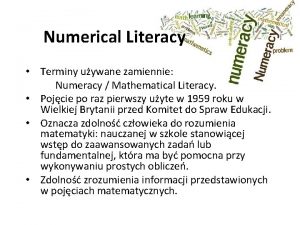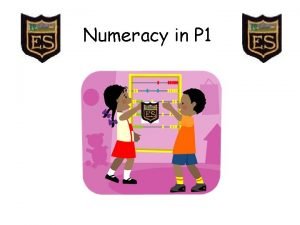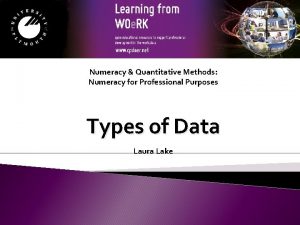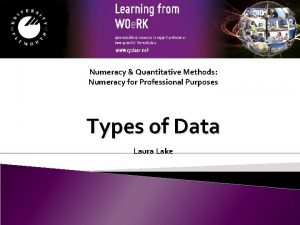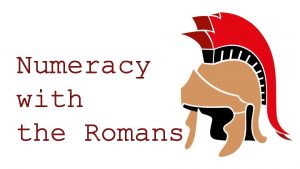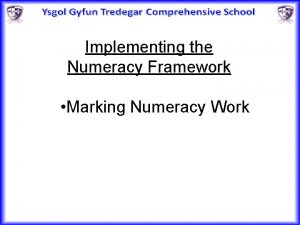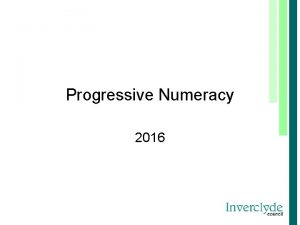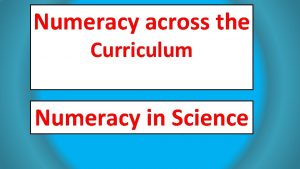An introduction to the Literacy and Numeracy unit






















- Slides: 22

An introduction to the Literacy and Numeracy unit standards

Slide show content • Requirements common to the Literacy and Numeracy unit standards • Information and resources available for planning, implementation, assessment and moderation • Evidence gathering and recording • Things to consider when planning for assessment 2

Background The following strategies and projects form the background to the Literacy and Numeracy unit standard development: • Government strategy to improve literacy and numeracy levels of all New Zealanders • Adult Literacy Strategy (TEC) • Alignment of Standards with the New Zealand Curriculum (Mo. E/NZQA) 3

Defining Literacy and Numeracy • Literacy is defined as: the written and oral language people use in their everyday life, learning and work. It includes reading, writing, speaking, and listening. Skills in this area are essential for good communication, active participation, critical thinking and problem solving. • Numeracy is defined as: the bridge between mathematics and daily life. It includes the knowledge and skills needed to apply mathematics to everyday family and financial matters, learning, work and community tasks, social and leisure activities. 4

Underpinning requirements The following requirements underpin all six standards: 1. Learner evidence as a whole must reflect the required level 2. Learner evidence must be naturally occurring 3. Learners’ skills are transferable, and demonstrated over a period of time 4. Learner evidence is assessed as a whole against the standard’s requirements 5. The title and purpose of each standard must be met 5

1. Level of the standards • The standards are registered at level one on the New Zealand Qualifications Framework. • The Literacy standards align to Step/Koru 4 on the Adult Literacy Learning Progressions. • The Numeracy standards align to Step/Koru 5 on the Adult Numeracy Learning Progressions. • The standards are not aligned to the NZ Curriculum. 6

2. Naturally occurring evidence The standards must be assessed on the basis of evidence that occurs naturally in real contexts (EN 2). • Naturally occurring evidence is derived from activities within a learning programme and/or from a candidate’s actual work performance and/or everyday life. – Evidence may be gathered from: • the classroom (from different courses, or different aspects of the same course) • the workplace • other contexts (eg family, sport, leisure, or community life). • Authenticity of learner work must be ensured. 7

3. Transferable competencies demonstrated over a period of time • The assessor must be satisfied that the learner’s literacy or numeracy skills are transferable – evidence of competence must be demonstrated across at least three separate activities (EN 2). • Evidence of competence must be demonstrated over a period of time – evidence must have been demonstrated over a period of at least one month (EN 3). 8

4. Assess learner’s performance as a whole The standards lend themselves to a portfolio approach: • Assess evidence of a learner’s performance as a whole against the requirements of the standard. • The learner’s portfolio of evidence must reflect (or exceed) the appropriate step/koru of the adult learning progressions. 9

4. Assess learner’s performance as a whole continued • Only standard 26622 (writing) requires all evidence requirements to be met in each piece of writing. • For standard 26625 (speaking), ER 1. 1 can be met across the portfolio of evidence (and ER 1. 2 must be met in each interaction). • In the rest, the evidence requirements can be met across the portfolio of evidence. 10

5. Title and purpose of standard must be met • Standard 26622 Write to communicate ideas for a purpose and audience • Standard 26623 Use number to solve problems • Standard 26624 Read texts with understanding • Standard 26625 Actively participate in spoken interactions • Standard 26626 Interpret statistical information for a purpose • Standard 26627 Use measurement to solve problems 11

Relationship to teaching and learning programmes So how do these unit standards relate to embedding the teaching and learning of literacy and numeracy into courses and programmes? • The embedding of literacy and numeracy teaching and learning is aimed at up-skilling learners so that they become more literate and more numerate. • The Literacy and Numeracy unit standards are used to credential learners – to verify they have met this minimum level of competence. 12

Resources available • From NZQA: Information and resources for planning and implementation, assessment and moderation • Adult Literacy and Numeracy Learning Progressions – www. literacyandnumeracyforadults. com 13

Assessment and moderation information and resources Available from www. nzqa. govt. nz/literacy-numeracy • National external moderation requirements • Assessed Work cover sheets (compulsory for national external moderation) • Clarifications of unit standards • Annotated exemplars • Evidence collection sheets for Literacy unit standards (including observation sheets for 26625) - optional 14

Evidence collection and recording requirements • Evidence may be collected by someone other than the Literacy/Numeracy standard assessor. • Ensure information about the situation and context from which the evidence is generated (EN 2), and the date it was generated on (EN 3) is recorded. • The authenticity of the learner evidence must be attested to. • Learner evidence (such as oral responses or practical performance) may need to be recorded (e. g. in writing or on video). Ensure this process has appropriate rigour. 15

Special assessment conditions Ensure evidence generated under special assessment conditions is valid: • Ensure any special assessment conditions do not compromise the valid assessment of the standard title, purpose and outcome statements. • Standard 26624 (reading) - reader assistance is not acceptable. • Standard 26622 (writing) – any writer assistance (including technological) must ensure the learner has independent control of the writing process. 16

Assessment of the portfolio of learner evidence Look at the portfolio as a whole, and ascertain whether or not: • the learner has achieved the standard title, purpose and outcome statement • the portfolio as a whole is sitting at or above the appropriate step on the adult learning progressions. Then check to ensure the requirements of the standard (explanatory notes, outcome statement, range requirements, evidence requirements) are met. 17

National external moderation • Evidence and documentation required for moderation is the same as that required to make the assessment decision. • Ensure documentation reflects that evidence was naturally occurring and generated over time. 18

Submission for national external moderation Please: • use current NZQA moderation cover sheets for each standard, and • use NZQA standard-specific Assessed Work cover sheets for each learner’s evidence Submissions must include: • learner evidence • information that supports and contextualises the learner evidence, and reflects standard requirements • assessor sign-off that the learner evidence, combined with the contextualising information, meets (or does not meet) the requirements of the standard • acceptable/correct answers where activities are derived from 19 a higher level of mathematics.

Considerations when in the planning stage • What are the underpinning requirements of the standards? • Where is evidence already generated? • Do further opportunities to generate evidence need to be incorporated into the course/programme? • Are adequate literacy and numeracy teaching support and learning opportunities incorporated into the course/ programme? • How will learners be identified? 20

Considerations continued • • How can learners’ progress be tracked? How will learners’ portfolios of evidence be managed? Who will collect evidence? Who will assess the learner portfolios against the standards? • Who will oversee the whole process? 21

Further information and assistance • For further information, go to www. nzqa. govt. nz/literacy -numeracy • For assistance, email tam@nzqa. govt. nz 22
 National literacy and numeracy learning progressions
National literacy and numeracy learning progressions National numeracy framework
National numeracy framework Literacy and numeracy secretariat
Literacy and numeracy secretariat Literacy learning progressions
Literacy learning progressions Scottish survey of literacy and numeracy
Scottish survey of literacy and numeracy Literacy and numeracy progressions
Literacy and numeracy progressions Numeracy unit standards
Numeracy unit standards Venn diagram of media information and technology literacy
Venn diagram of media information and technology literacy Site:slidetodoc.com
Site:slidetodoc.com Difference of people in media and people as media
Difference of people in media and people as media Cyber literacy and digital literacy
Cyber literacy and digital literacy Cartoon analysis about media and information literacy
Cartoon analysis about media and information literacy What numeracy covers
What numeracy covers National numeracy challenge
National numeracy challenge Numeracy learning continuum
Numeracy learning continuum Figurative counting
Figurative counting Balanced math framework
Balanced math framework Numeracyskills.com.au
Numeracyskills.com.au Numeracy across the curriculum audit
Numeracy across the curriculum audit Grade 10 numeracy assessment practice test
Grade 10 numeracy assessment practice test Form time numeracy
Form time numeracy Qax numeracy
Qax numeracy Seal numeracy
Seal numeracy
